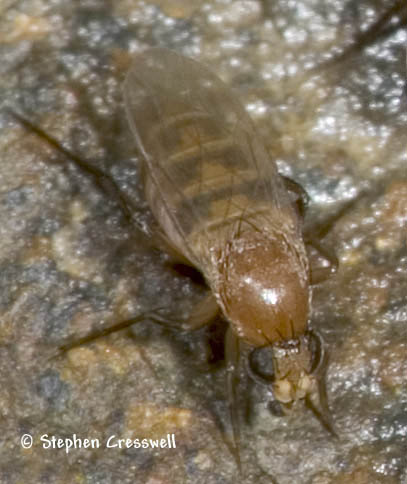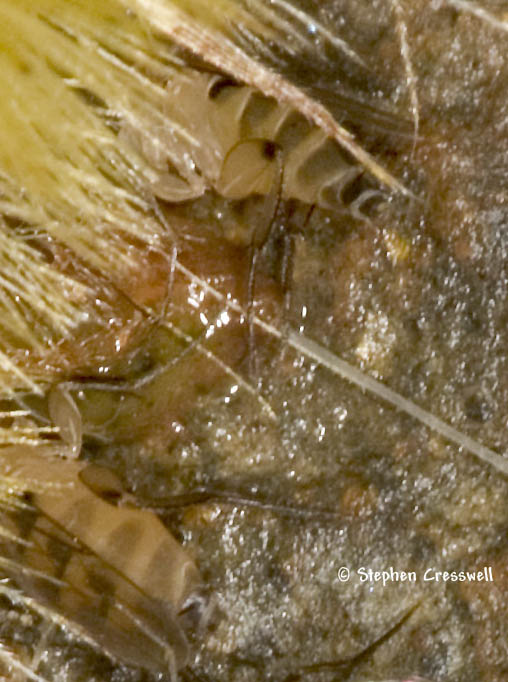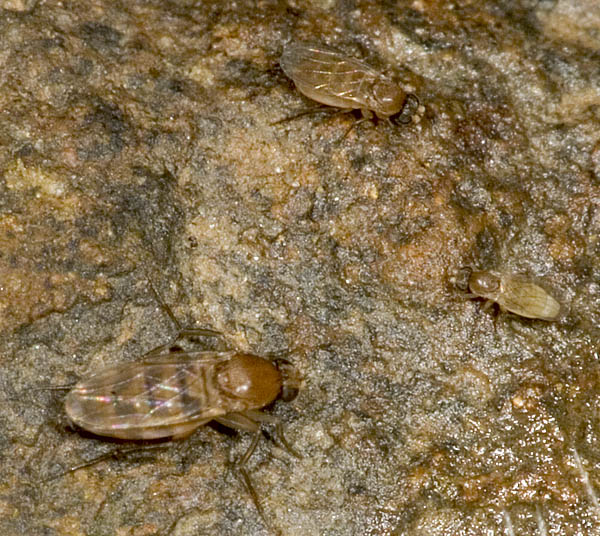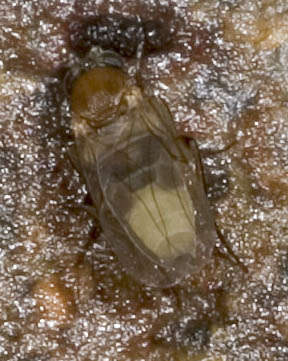Diptera.info :: Identification queries :: Diptera (adults)
Who is here? 1 guest(s)
|
Flies and Caterpillar
|
|
| Stephen |
Posted on 09-09-2006 12:32
|
|
Member Location: West Virginia USA Posts: 1322 Joined: 12.04.05 |
These small flies were harrassing a badly wounded caterpillar. Their size seemed to vary considerably but most were 2.0 to 3.0 mm. Woodland, West Virginia USA, yesterday. Not too many bristles. Two convergent ones on the scutellum, and three more where the thorax meets the head. The femurs are thick, as the second picture will show. Could they be Chloropidae? I remember reading that some Chloropidae are attracted to wounds. The third photo will show some of the size variation; see comments with that third photo. Stephen attached the following image:  [59.85Kb] Edited by Stephen on 09-09-2006 13:01 --Stephen Stephen Cresswell www.americaninsects.net |
| Stephen |
Posted on 09-09-2006 12:35
|
|
Member Location: West Virginia USA Posts: 1322 Joined: 12.04.05 |
Not for the squeamish. These two flies are feeding at the caterpillar's wound. There seems to be an organ present. I'm posting this picture mostly to show the thick femora.
Stephen attached the following image:  [92.2Kb] --Stephen Stephen Cresswell www.americaninsects.net |
| Stephen |
Posted on 09-09-2006 13:08
|
|
Member Location: West Virginia USA Posts: 1322 Joined: 12.04.05 |
This photo shows three flies present at the wounded caterpillar. The largest fly in this picture measures 3.0 mm. The one at rear seems smaller, and the one at right seems much smaller. Maybe the one at right is the same family but a different species? Stephen attached the following image:  [136.04Kb] Edited by Stephen on 09-09-2006 13:11 --Stephen Stephen Cresswell www.americaninsects.net |
| Tony Irwin |
Posted on 09-09-2006 13:10
|
|
Member Location: Norwich, England Posts: 7280 Joined: 19.11.04 |
You've captured some very interesting behaviour, Stephen. These are scuttle flies - Phoridae. Brian Brown is the Nearctic phorid guru - here's the link to his webpages: http://www.phorid...ridae.html. I'm sure he'd be very interested to hear of your observations, and may well be able to tell you which species is involved.
Tony ---------- Tony Irwin |
|
|
|
| Stephen |
Posted on 09-09-2006 13:14
|
|
Member Location: West Virginia USA Posts: 1322 Joined: 12.04.05 |
Thanks for the family ID and other information, Tony. I will check out Brian Brown's website and get in touch with him. Another new family to me, I can barely keep up! --Stephen Stephen Cresswell www.americaninsects.net |
| Stephen |
Posted on 09-09-2006 13:25
|
|
Member Location: West Virginia USA Posts: 1322 Joined: 12.04.05 |
As long as I am documenting the different Phorids present at the caterpillar, here is one more. Maybe this is the same species as the smallest one in the photo above? The photo looks a little odd because the fly had its head lowered and abdomen raised. Measuring from the photo I come up with 2.0 mm as the length of this fly, but the measurement may be a little short because of the fly's posture. Stephen attached the following image:  [61.38Kb] --Stephen Stephen Cresswell www.americaninsects.net |
| Kahis |
Posted on 09-09-2006 13:26
|
|
Member Location: Helsinki, Finland Posts: 1999 Joined: 02.09.04 |
IIRC some phorids develop as 'opportunistic parasitoids' in wounded insects and other animals. The larvae cannot enter through the cuticle of a healthy host, but a wounded or freshly dead host is vulnerable. Feeding continues after the host is dead. Such development pattern is known also for other families, at least chloropidare and sarcophagidae.
Kahis |
| Stephen |
Posted on 09-09-2006 18:39
|
|
Member Location: West Virginia USA Posts: 1322 Joined: 12.04.05 |
Kahis, thanks for the life history information--I always enjoy reading this kind of information. At Tony's suggestion I did ask Brian Brown if he would have a look at this page and was nice enough to do so. Here is his reply: "Stephen: Thanks for sending me your interesting photos. The larger phorids are Megaselia scalaris, a species with which you are familiar from my FAQ page. It is a common scavenging species, sometimes attacking injured or incapacitated hosts. It might have just been feeding. The other species (the smaller one with a white-tipped abdomen) is Megaselia perdita, another scavenger although we know less about it than M. scalaris. Feel free to post my response to the diptera.info site." Thanks again Brian, Kahis and Tony! --Stephen Stephen Cresswell www.americaninsects.net |
| Jump to Forum: |














